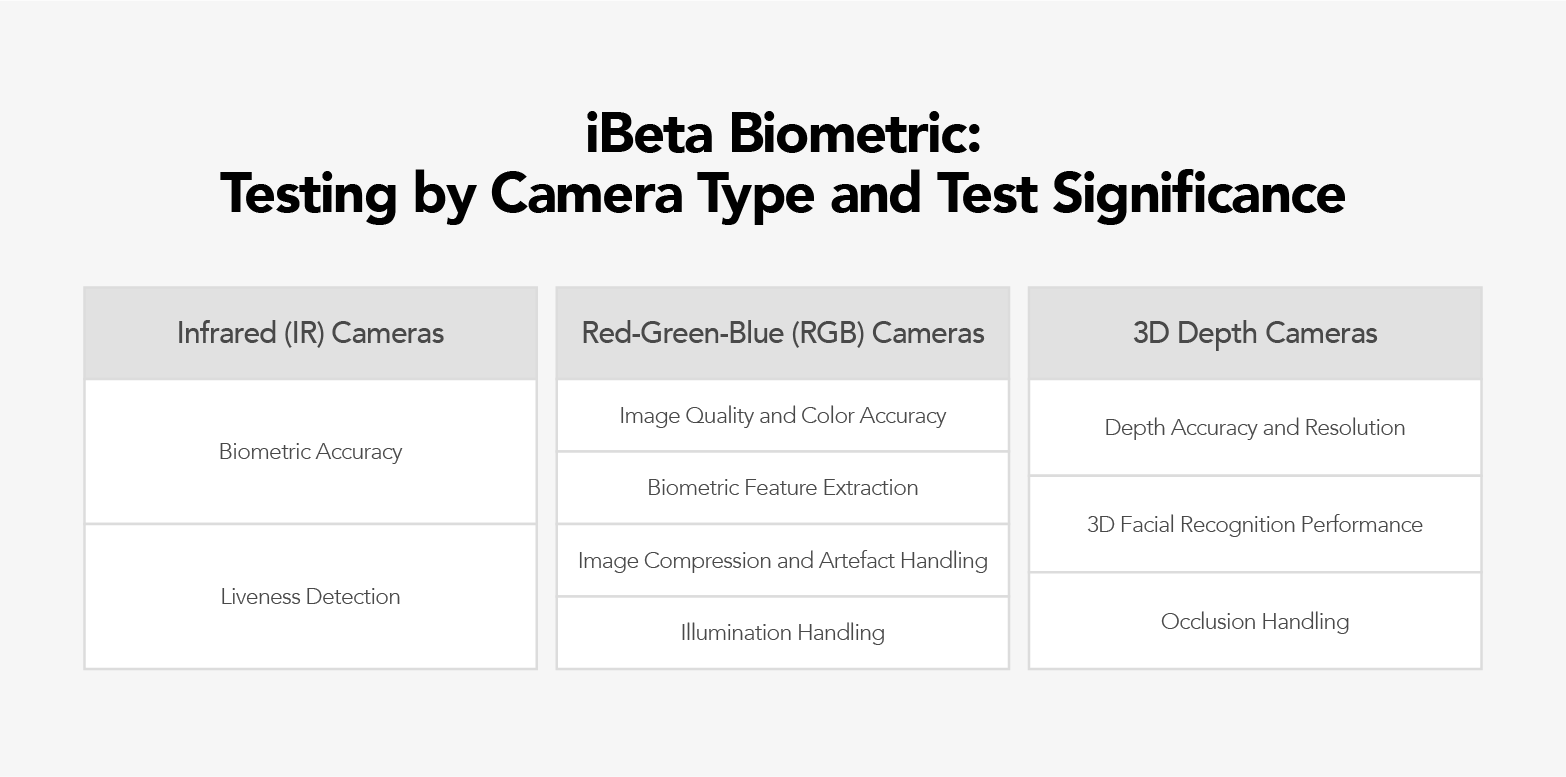The Importance of iBeta’s Passive Liveness Detection Testing - Part 1
ALCHERA
June 29, 2023
June 29, 2023
A thorough exploration of iBeta testing: diverse testing methodologies, testing strategies, and the evolving landscape of liveness detection testing.
Table of Contents
iBeta: Test Types and Testing Development
• iBeta biometric testing
• Contributions and development direction of iBeta testing
iBeta Biometric: Testing by Camera Type and Test Significance
• iBeta testing for infrared (IR) cameras
• iBeta testing for red-green-blue (RGB) cameras
• iBeta testing for 3D depth cameras
iBeta Test Content by Detection Method: Active and Passive Methods
• iBeta testing of the active liveness detection method
• iBeta testing of the passive liveness detection method
• Difference between Active and Passive Methods
Passive Liveness Detection in AI Applications: Enhancing Biometrics, Security Systems, and Fraud Detection
• Passive liveness detection in biometrics
• Passive liveness detection in security systems
The Future of Passive Liveness Detection
ALCHERA's Facial Recognition Solution Passes iBeta's PAD Test with 100% Accuracy

iBeta is a renowned software testing and quality assurance company that provides a wide range of testing services to clients across diverse industries. With its commitment to delivering high-quality results and adherence to industry standards, iBeta has established itself as a trusted partner for companies seeking robust testing solutions.
iBeta: Test Types and Testing Development
Founded in 1999, iBeta initially focused on providing software testing services for web applications. Over time, it expanded its expertise to include mobile apps, desktop software, embedded systems, and other software domains.
iBeta biometric testing
iBeta specializes in biometric testing, which involves evaluating the accuracy and reliability of biometric systems such as fingerprint recognition, facial recognition, and iris scanning. This testing ensures that biometric technologies perform accurately and consistently in real-world scenarios.
Contributions and development direction of iBeta testing
iBeta contributions
iBeta has made significant contributions in the field of software testing and quality assurance.
Expertise in biometric testing
iBeta has established itself as a leader in biometric testing, including passive liveness detection. They have developed specialized knowledge and expertise in assessing the performance, accuracy, and reliability of biometric systems. This expertise contributes to advancing biometric technologies, enhancing security and trust in applications relying on biometric authentication.
Certification and compliance testing
iBeta is an accredited testing laboratory for various industry certifications and standards. Their involvement in certification and compliance testing ensures that software applications meet the required industry standards and regulatory requirements. This helps clients gain certifications, meet compliance obligations, and have confidence in the security and quality of their products.
Embracing emerging technologies
iBeta is actively involved in keeping pace with emerging technologies and trends. They adapt their testing methodologies, tools, and frameworks to address the unique challenges posed by new technologies such as artificial intelligence (AI), machine learning (ML), and the Internet of Things (IoT). This allows iBeta to provide relevant and effective testing solutions for cutting-edge software applications.
iBeta development direction
iBeta continues to evolve and expand its capabilities to meet the evolving needs of the software industry.

iBeta Biometric: Testing by Camera Type and Test Significance
iBeta plays a crucial role in ensuring the optimal functioning of various applications that rely on biometric data, such as infrared cameras (IR), red-green-blue (RGB) cameras, and 3D depth cameras.
iBeta testing for infrared (IR) cameras
Infrared cameras capture and detect infrared radiation, which is invisible to the human eye. They are commonly used in biometric applications such as facial recognition, vein pattern recognition, and iris scanning. iBeta conducts specific tests for IR cameras to assess their performance and functionality in biometric systems:
-
Biometric accuracy: iBeta verifies the accuracy of IR cameras in capturing biometric features. For example, in facial recognition, the cameras must accurately capture and represent facial characteristics in the infrared spectrum. iBeta evaluates the cameras' ability to capture and process biometric data with high precision.
-
Liveness detection: In some biometric systems, liveness detection is crucial to ensure the presented biometric sample is from a live person and not a spoofing attempt. iBeta tests the effectiveness of IR cameras in detecting liveness cues, such as thermal signatures, to prevent fraudulent access to biometric systems.
iBeta testing for red-green-blue (RGB) cameras
RGB cameras are commonly used in biometric applications such as facial recognition, fingerprint scanning, and palm print identification. iBeta conducts specific tests to evaluate the performance and quality of RGB cameras in biometric systems:
-
Image Quality and Color Accuracy: iBeta tests the image quality of RGB cameras used for biometric purposes, including factors like resolution, color accuracy, noise levels, and sharpness. Accurate representation of colors and details in captured biometric images is essential for reliable identification and authentication.
-
Biometric Feature Extraction: iBeta evaluates the cameras' ability to capture and extract biometric features accurately. For example, in facial recognition, the cameras must capture facial landmarks and features with high fidelity to enable effective matching algorithms. iBeta verifies the cameras' capability to provide precise biometric data for subsequent processing.
-
Image Compression and Artefact Handling: iBeta tests how RGB cameras handle image compression algorithms and handle artifacts introduced during compression. This is important to ensure that the quality and integrity of biometric data are maintained even after compression, as compression artifacts may affect the accuracy of subsequent biometric processing.
-
Illumination Handling: iBeta assesses how well RGB cameras handle different lighting conditions and illumination variations. This includes evaluating the cameras' ability to adjust exposure, handle backlighting, and capture biometric data accurately in various lighting environments.
iBeta testing for 3D depth cameras
3D depth cameras, often using technologies such as structured light or time-of-flight, capture depth information in addition to RGB imagery. They are utilized in biometric applications such as 3D facial recognition and hand gesture recognition. iBeta conducts specific tests to ensure the accuracy and reliability of 3D depth cameras in biometric systems:
-
Depth Accuracy and Resolution: iBeta tests the accuracy and resolution of depth measurements provided by 3D cameras. This involves evaluating how well the cameras capture and represent the spatial information of biometric features. Accurate depth information is crucial for reliable and robust biometric identification.
-
3D Facial Recognition Performance: In 3D facial recognition systems, iBeta evaluates the performance of 3D depth cameras in capturing facial geometry and features. This includes assessing the cameras' ability to accurately capture facial landmarks, contours, and surface details, which are essential for precise 3D facial recognition algorithms.
-
Occlusion Handling: iBeta assesses how well 3D depth cameras handle occlusions, such as objects partially obstructing the biometric data. This is important to ensure that accurate depth information is captured, even when certain parts of the biometric sample are partially occluded or hidden.
By evaluating the specific test content and significance associated with different camera types, iBeta assists in developing robust and trustworthy biometric solutions that meet the demanding requirements of various applications, including security, access control, and identity verification.
iBeta Test Content by Detection Method: Active and Passive Methods
When it comes to biometric testing, iBeta employs different detection methods to evaluate the performance and accuracy of biometric systems. Two commonly used methods are active and passive detection. iBeta provides the test content specific to each method.
iBeta testing of the active liveness detection method
The active detection method involves actively stimulating or interacting with the biometric system to capture the biometric data. It typically requires the user's participation or cooperation. For example, in fingerprint recognition, the user actively places their finger on a sensor to capture the fingerprint data. Similarly, in face recognition, the user actively positions their face within the camera's field of view.
The active method offers several advantages, such as user involvement and feedback, which can help ensure accurate and reliable biometric data capture. However, it may also have limitations, such as user discomfort or difficulties in capturing consistent biometric samples.
Active liveness detection testing method
-
Non-Intrusive Data Collection: iBeta conducts tests to evaluate the system's ability to collect biometric data non-intrusively. This includes assessing the accuracy and reliability of the data capture process without requiring the user to actively participate or interact with the system.
-
Unobtrusive Monitoring: In some cases, the passive method involves unobtrusive monitoring of the user's biometric characteristics in real-time. iBeta evaluates the system's ability to monitor and analyze the biometric data passively without disrupting the user's activities or requiring their active participation.
-
Performance under Real-World Conditions: iBeta tests the system's performance under real-world conditions to assess its effectiveness and reliability. This includes evaluating its performance in different environments, lighting conditions, and scenarios that users may encounter in their everyday lives.
iBeta testing of the passive liveness detection method
The passive detection method involves capturing biometric data without any active involvement or cooperation from the user. It relies on sensors or cameras that can capture the biometric data passively. For example, in facial recognition, the system passively captures the user's facial features through cameras or sensors without the need for the user to actively position their face or interact with the system.
The passive method offers advantages such as convenience, as it does not require explicit user cooperation. It can be more user-friendly, as users can be authenticated or identified without taking specific actions. However, the passive method may have technical challenges related to accuracy, robustness, and handling of varying environmental conditions.
Difference between Active and Passive Methods
While active liveness methods may offer a more straightforward technological development process, there are still challenges and complexities to consider. The involvement of user interaction does simplify certain aspects of development, as developers can design the system to provide clear instructions and prompts for users to follow during the data capture process. Additionally, contact-based sensors commonly used in active methods, such as fingerprint sensors or touch-based facial recognition systems, have well-established integration protocols and interfaces, making their incorporation into the system relatively easier. However, active liveness methods also face challenges. The accuracy and reliability of capturing biometric data through user interaction can vary based on factors such as user compliance, positioning, and variations in pressure or touch. Ensuring consistent and precise data capture across different users and scenarios requires careful calibration and testing.
On the other hand, passive liveness methods introduce additional complexities. The goal of capturing biometric data seamlessly and non-intrusively presents technical challenges. Passive methods often rely on non-contact or remote sensing technologies, such as cameras or depth sensors, which require advanced technological expertise for their integration and calibration. These sensors need to be accurately positioned, calibrated, and synchronized to capture reliable biometric data without user involvement.
Passive liveness methods are also more susceptible to environmental factors, including variations in lighting, distance, noise, and other external interferences. Ensuring accurate and consistent data capture under diverse real-world conditions requires sophisticated algorithms and signal processing techniques. Developing algorithms that can handle these variations and extract accurate biometric information can be technically challenging.
Nevertheless, advancements in sensor technology, machine learning, and computer vision algorithms are playing a significant role in simplifying the development of both active and passive liveness methods. Sensors are becoming more sophisticated, capable of capturing higher-quality data in challenging environments. Machine learning algorithms are being leveraged to analyze and interpret complex data patterns, improving the accuracy and reliability of both active and passive liveness methods. Computer vision techniques are being utilized to handle environmental variations and extract meaningful biometric information from captured data.
The ongoing progress in these areas is reducing the technological complexities associated with active and passive liveness methods. As sensor technology continues to advance, incorporating more robust and accurate sensors, and as algorithms improve, enabling better data interpretation, the development of both active and passive liveness methods becomes more accessible and reliable for various applications.
Passive Liveness Detection in AI Applications: Enhancing Biometrics, Security Systems, and Fraud Detection
Passive liveness detection is a crucial component in the field of biometrics, security systems, and fraud detection. By analyzing subtle cues and characteristics, passive liveness detection helps enhance the security, reliability, and trustworthiness of various applications that rely on biometric authentication.
Passive liveness detection in biometrics
Biometric authentication systems, such as facial recognition, fingerprint recognition, and iris scanning, rely on the uniqueness and permanence of biometric traits for identity verification. However, these systems can be vulnerable to spoofing attacks wherein adversaries attempt to present artificial or non-living samples to deceive the system. Passive liveness detection addresses this vulnerability by leveraging AI algorithms to analyze the presented biometric sample and determine its liveness.
-
Facial recognition: In facial recognition systems, passive liveness detection algorithms analyze various facial cues such as micro-expressions, eye movement, and skin texture to identify signs of liveness. This helps prevent spoofing attempts using printed photographs, masks, or other non-living samples.
By incorporating passive liveness detection, biometric systems become more robust, accurate, and resistant to spoofing attacks, enhancing overall security and reliability in applications such as access control, identity verification, and financial transactions.
Passive liveness detection in security systems
Passive liveness detection plays a vital role in enhancing the security of various systems, including surveillance systems, border control, and secure access control.
-
Surveillance systems: AI-powered surveillance systems can utilize passive liveness detection to distinguish between live subjects and fraudulent activities in real time. By analyzing facial movements, behavioral patterns, or physiological indicators, these systems can identify potential threats, intrusions, and unauthorized access attempts.
-
Border control: At border control checkpoints, passive liveness detection technologies provide an added layer of security by verifying the liveness of biometric samples presented during passport or identity document checks. This helps prevent identity theft and the use of forged documents.
- Secure access control: In high-security environments, such as government facilities or data centers, passive liveness detection can be incorporated into access control systems. By analyzing biometric traits, such as fingerprints and facial features, these systems can ensure that only authorized individuals gain access, preventing unauthorized entry using fake or stolen biometric data.
The Future of Passive Liveness Detection
Passive liveness detection is expected to play an increasingly crucial role in biometric authentication and security systems. Here are some key aspects that highlight the future of passive liveness detection:
-
Advancements in algorithms: The future of passive liveness detection will witness advancements in algorithms and machine learning techniques. These advancements will enhance the accuracy and reliability of liveness detection by analyzing more subtle cues, such as micro-expressions, skin texture, and physiological indicators.
-
Usability and user experience: Passive liveness detection will focus on providing a seamless and user-friendly experience. Advancements in sensor technology will enable non-intrusive and convenient data capture, minimizing false rejection rates, and ensuring ease of use across diverse user populations.
-
Cross-modal biometrics: The integration of multiple biometric modalities, such as face, voice, and behavioral traits, with passive liveness detection, will enhance the robustness and security of biometric systems. This multimodal approach will increase the complexity of spoofing attempts, further strengthening the overall security posture.
However, while passive liveness detection brings significant benefits, it also faces potential challenges. Here are some challenges and possible solutions:
-
Evolving spoofing techniques: Adversaries continually develop sophisticated spoofing techniques, posing challenges for passive liveness detection. Solutions include ongoing research and innovation to identify and address new spoofing methods, continuous improvement of detection algorithms, and proactive monitoring of emerging threats.
-
Environmental factors: Passive liveness detection is susceptible to variations in environmental conditions, such as lighting, distance, and noise. Solutions involve advanced algorithms that can handle environmental variations, sensor calibration techniques, and robust preprocessing techniques to ensure accurate data capture under diverse real-world conditions.
-
Usability and user acceptance: Passive liveness detection should strike a balance between security and user experience. Solutions include iterative testing, user feedback sessions, and continuous optimization of algorithms to minimize false rejection rates and ensure a seamless user experience.
Addressing these challenges requires collaborative efforts from industry stakeholders, including iBeta, research institutions, technology providers, and regulatory bodies. By continuously improving algorithms, staying vigilant to evolving threats, and promoting ethical practices, the potential challenges of passive liveness detection can be effectively mitigated, ensuring its successful integration and widespread adoption in biometric authentication and security systems.
ALCHERA's Facial Recognition Solution Passes iBeta's PAD Test with 100% Accuracy
ALCHERA has successfully passed iBeta's PAD (Presentation Attack Detection) test, certifying the reliability of its facial recognition solution. The test utilized a camera with standard specifications and achieved an outstanding 100% accuracy rate in identifying fake faces that were disguised as different individuals. ALCHERA takes great pride in being the first company in Korea to receive certification for its passive solution, which effortlessly detects a person's face without necessitating specific actions like adjusting the face's position. In contrast to other solutions that rely on Depth cameras, ALCHERA's technology can seamlessly integrate with conventional cameras. ALCHERA's dedication to proactive data building and commercialization has resulted in the successful passing of iBeta's internationally recognized software functional test.
...
...




